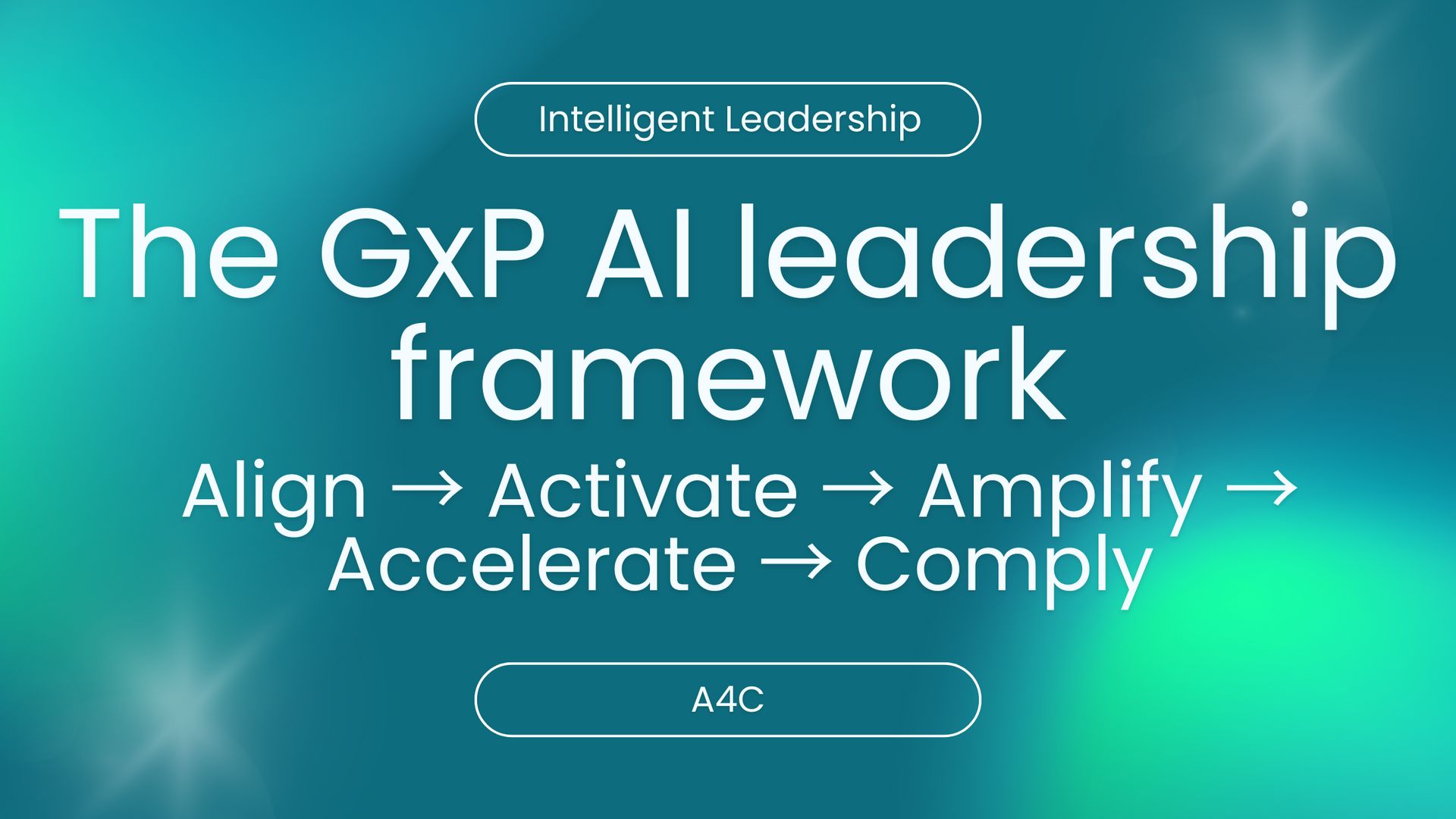- xLM's ContinuousTV Weekly Newsletter
- Posts
- #081: The GxP AI leadership framework: Align→Activate→Amplify →Accelerate→Comply (A4C)
#081: The GxP AI leadership framework: Align→Activate→Amplify →Accelerate→Comply (A4C)
AI leaders in pharma, medtech, and biotech face an impossible task:”Move as fast as Silicon Valley, yet validate as rigorously as the FDA requires”

Table of Contents
1. Introduction
AI’s pace is breathtaking. In two years, frontier model releases have increased over 5.6×, while compute costs for GPT-class systems dropped 280×. In GxP-regulated industries, where patient safety and product quality define success, this rapid progress brings both opportunity and risk.
AI leaders in pharma, medtech, and biotech face an impossible task:
”Move as fast as Silicon Valley, yet validate as rigorously as the FDA requires”
The future belongs to those who do both. To succeed, leaders must evolve from traditional digital champions into GxP AI leaders, executives who embed compliance into innovation.
2. Why GxP AI leadership matters now?
The AI revolution is not a technology upgrade, it’s a compliance transformation.
Regulators prepare for this shift:
FDA’s AI/ML Action Plan emphasizes lifecycle monitoring, transparency, and retraining oversight.
EMA Annex 22 (draft) outlines expectations for AI in manufacturing and quality systems.
ISO/IEC 42001:2023 introduces the first management system standard for AI governance.
Yet most enterprises remain unprepared. A recent survey found that over 60% of AI initiatives in life sciences stall before validation, and fewer than 15% have live audit traceability.Being a GxP AI leader means shifting AI adoption from experiments to evidence-driven operations, balancing innovation speed with rock solid assurance.
3. The GxP AI leadership framework: Align → Activate → Amplify → Accelerate → Comply (A4C)
This framework embeds continuous validation, auditability, and risk-based oversight at every stage.
Each stage is a strategic, technical, and cultural leadership mandate.
3.1. ALIGN — Connect AI vision with GxP reality
AI alignment starts with purpose. For GxP leaders, alignment means translating business goals into validated AI outcomes that serve compliance, safety, and efficiency.
Leadership imperative:
Every AI use case must map to an operational KPI and a regulatory requirement.Actions to implement:
Create an AI Governance Charter linking each use case to clauses in, for example, 21 CFR Part 11, Annex 11, Annex 22 or ISO 42001.
Define acceptable use boundaries specifying which tasks use AI outputs and which require human review.
Establish an AI–Quality Council co-led by IT and QA to ensure traceability from model conception to release.
Conduct regular alignment audits to confirm every active AI system has a documented purpose, owner, and validation status.
Leadership question:
Is our AI vision explicitly tied to quality, safety, and compliance outcomes?
3.2. ACTIVATE — Empower people, institutionalize guardrails
AI adoption fails not for lack of tools but because of fear and inconsistency. GxP AI leadership transforms culture by giving teams freedom to innovate and guardrails to stay compliant.
Leadership imperative:
Innovation must be encouraged, but every experiment should leave a compliance footprint.Actions to implement:
Deploy validated AI sandboxes for controlled environments where teams can experiment under audit-logged conditions.
Automate prompt and model documentation to capture and version all prompts, datasets, and outputs.
Develop AI Literacy Programs targeting three personas:
Developers for validation and explainability requirements
Quality Professionals for interpreting AI outputs and evidence
Executives with risk appetite and governance metrics
Introduce “AI Day” workshops to showcase compliant prototypes and reward validated innovation.
Leadership question:
Do our teams have the knowledge, permission, and guardrails to innovate safely?
3.3. AMPLIFY — Scale Proven, Validated AI Solutions
Once early wins appear, the GxP AI leader must amplify. Scaling AI responsibly means converting validated prototypes into standardized, reusable digital assets to align compliance with value.
Leadership imperative:
What’s validated once should never be re-validated from scratch.Actions to implement:
Create a “Validated AI Repository” with reusable models, test scripts, and validation summary reports (VSRs).
Standardize metadata for each AI asset to include owner, version, data lineage, intended use, and validation evidence.
Introduce “compliance inheritance” to reuse prior validation evidence when retraining within defined parameters.
Build internal AI storytelling channels, videos, town halls, and dashboards showing measurable quality and efficiency gains.
Metrics to track:
Percentage of AI assets reused without revalidation
Mean time from prototype to deployment
Reduction in manual documentation time
Leadership question:
How efficiently do we reuse validated knowledge to accelerate safe scaling?
3.4. ACCELERATE — From Pilot to Production, Without Losing Control
Speed defines competitive AI, but for GxP organizations, speed must rest on validation automation. Acceleration comes not from skipping steps but from systematizing them.
Leadership imperative:
Move fast but within a controlled, evidence-producing pipeline.Actions to implement:
Embed Continuous and Intelligent Validation systems to automatically track configuration, test results, and change impact.
Use AI-driven risk assessments to decide when full or partial revalidation is needed after a model update.
Maintain digital twins of validation environments to test updates before deployment.
Integrate compliance APIs connecting LIMS, MES, and AI workflows so traceability and audit readiness update in real time.
Leadership question:
Can our AI systems prove their own compliance continuously, not just at release?
3.5. COMPLY — Build Trust Through Continuous Integrity
Compliance isn’t an endpoint it’s a living discipline. The modern GxP AI leader turns compliance from a checkbox into a real-time integrity assurance system.
Leadership imperative:
Compliance must be continuous, evidence immutable, and trust demonstrable.Actions to implement:
Implement Continuous data integrity and monitoring to enforce immutability, versioning, and field protection.
Use AI explainability dashboards for every production model to record rationales and data lineage for each decision.
Align AI governance with ISO/IEC 42001:2023 clauses like context of organization, leadership, operation, and improvement.
Automate compliance reporting to generate monthly AI integrity dashboards for internal and external audits.
Outcome:
Audit readiness shifts from reactive (weeks of evidence gathering) to proactive (instant dashboard-driven transparency).
Leadership question:
Can we demonstrate continuous integrity any time, for any audit?
4. Becoming a True GxP AI Leader
AI success in regulated industries isn’t just measured by algorithmic accuracy. It is measured by auditable reproducibility and regulatory confidence.
A true GxP AI leader:
Sees compliance as a competitive advantage, not a constraint.
Treats validation as a living process, not a one-time event.
Builds teams that think in systems of proof, not systems of performance.
Measures success in both efficiency metrics (time to production, FTR improvement) and integrity metrics (audit readiness, data lineage, validation velocity).
When organizations adopt this dual mindset, AI becomes both scalable and sustainable accelerating innovation while upholding patient safety, product quality, and data integrity.
5. Three Diagnostic Questions for GxP AI Leaders
Traceability:
Can I trace every AI-driven decision to a dataset, model version, and validation record?Accountability:
Are there named owners and approvers for every stage of our AI lifecycle?Auditability:
Can we demonstrate compliance posture in real time, not after weeks of evidence hunting?
6. Call to Action
The path to responsible, scalable, and compliant AI leadership starts now. Whether your organization pilots generative models or operationalizes predictive twins, the next leap isn’t just about more AI it’s about trusted AI.
“AI doesn’t replace human judgment it demands human integrity.
GxP AI leaders don’t just build models, they build trust at scale.”
7. References
Staying ahead in the age of AI: A leadership guide by OpenAI.
Reply